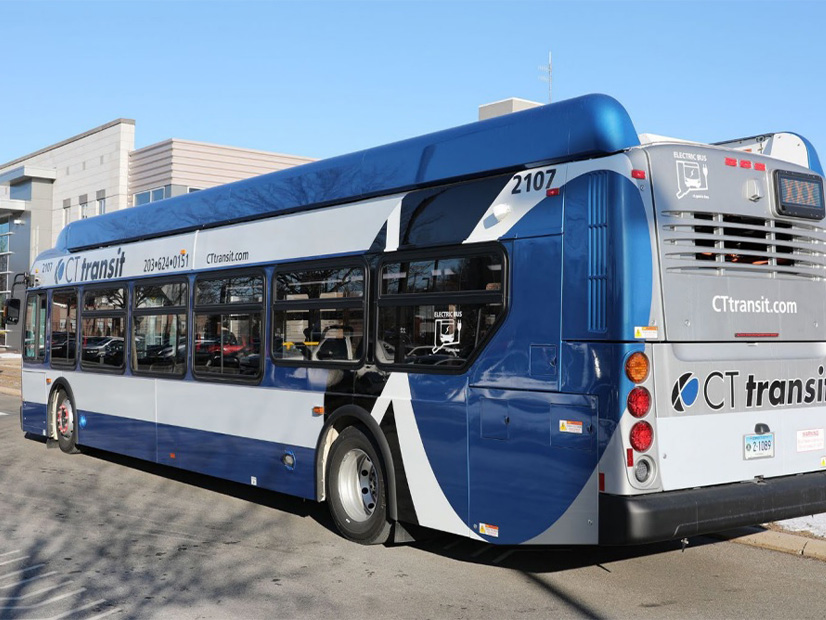
The top beneficial action Connecticut regulators can take to help electrify CTtransit’s 600-bus fleet is to ensure “predictability in costs,” Rabih Barakat of the Connecticut Department of Transportation said Thursday.
“Innovative rate design is really needed for enabling the conversion for the statewide bus fleet to battery electric,” said Barakat, who is transportation division chief for facilities and transit in the Bureau of Engineering and Construction. “It’s very difficult under the current design to meet … mandates for a 30% [transition] by 2030 and 100% by 2035.”
Affordable charging would support the bus fleet transition and ConnDOT’s goal to maintain service levels, he said in a presentation for the Public Utilities Regulatory Authority’s investigation into integration of medium- and heavy-duty electric vehicles (M-HDEV).
PURA launched the investigation last fall and sought ConnDOT’s input on the Connecticut Electric Bus Initiative for the first technical meeting in the proceeding Thursday. The authority’s investigation will examine potential rate design and infrastructure solutions, with a particular focus on transit buses.
CTtransit, which is a ConnDOT-owned bus service, currently has 10 battery electric buses (BEB) in operation, with another five in preservice preparation, according to Graham Curtis, assistant transit administrator for bus capital programs at the Bureau of Public Transportation.
“We anticipate ordering another 50 buses this year,” he said.
Under ConnDOT’s current bus electrification plan, the department expects to convert 60% of its fleet by 2030, more than doubling the requirement for that year. It expects all its buses to be electric by 2031, which would be four years ahead of the 2035 requirement.
In the first quarter of this year, the department paid Avangrid subsidiary United Illuminating 23 cents/kWh for on-peak charging and 22 cents/kWh for off-peak, with a $10.81/kW demand charge and $10.06/kW transmission charge.
ConnDOT is trying to work with the utility to arrange a better charging rate design, Graham said, adding that he is “optimistic” that they can find a “suitable solution.”
Task Force Report
Improved rate design for M-HDEV charging is one of the major recommendations in a Multi-state Zero-emission Vehicle Task Force’s March 10 draft framework for reducing truck and bus emissions. The task force is an initiative of an M-HDEV memorandum of understanding signed by Connecticut, 15 other states, D.C. and Quebec. PURA said it launched the M-HDEV investigation to support the goals of the MOU.
“Rate reform is needed to mitigate demand charges and incentivize fleet charging during lower-cost off-peak periods and periods of high renewable energy generation,” the task force report said.
The task force recommended that utility regulators establish commercial charging rates and customer incentive programs that recover utility costs and lower charging costs. Commercial rates would mitigate demand charges and give commercial customers price signals that benefit the grid, the report said.
In addition, the task force recommended that regulators design revenue-generating vehicle-to-grid services for M-HDEV fleets that have the same value as traditional grid services.
Rate structures should focus on “long-term sustainable rate design solutions that offer time-variant rates, promote off-peak charging and charging during periods of peak renewable energy generation, avoid non-coincident peak demand charges, and are consistent for all utilities,” the report said.
Utilities in California, Hawaii and Colorado already have novel rate models that regulators can look to for ideas, the report said.
Hawaiian Electric, for example, has a pilot rate for critical peak pricing that eliminates demand charges for bus fleet customers during periods of high solar generation or low electricity demand. And Pacific Gas and Electric has a high-use business rate that carries a monthly subscription charge and a tiered time-of-use rate.
PURA expects to hold additional technical meetings over the summer for its M-HDEV investigation and issue a final decision in December.


